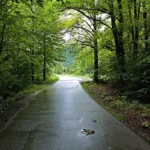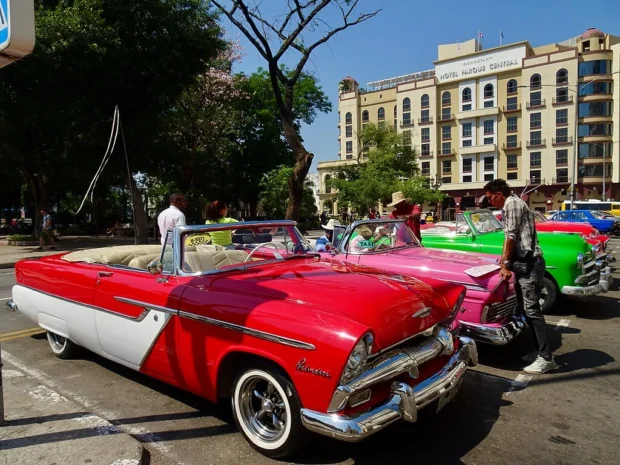Havana is a city that carries stories in every corner. Old cars roll slowly down wide, sunlit streets. Buildings lean just enough to make you wonder about the years they have seen. If you hear music floating through the air, it’s likely coming from someone’s balcony or a small cafe. Cuba’s capital doesn’t shout for attention, but those who stay a little longer find it full of character and surprises. Getting to know Havana means walking its paths, tasting its flavors, and chatting with people who remember a different time.
Table of Contents
After immersing yourself in Havana’s vibrant streets and rich culture, you might enjoy reading about Santiago Chile’s unique blend of city life and nature, offering another perspective of Latin American urban charm.
After exploring Havana’s vibrant streets and rich culture, travelers with a taste for history might find a visit to India Gate in Delhi a rewarding experience, where another nation’s stories and landmarks await discovery in India’s capital.

Walking Through Havana’s Historic Heart
Start where old Havana, or Habana Vieja, shows off its colonial past. The place has a mix of crumbling walls and freshly painted doors. Plaza Vieja is a good spot to pause. Surrounded by colorful buildings, it often hosts artists selling paintings or musicians playing softly. Nearby, the Cathedral of Havana reaches towards the sky with its classic baroque design. You can join the flow of locals and visitors here, sitting at a cafe sipping strong coffee.

Right next to these well-known spots is a quieter area. Callejón de Hamel is a small alley painted with bright murals inspired by Afro-Cuban culture. On Sundays, there’s live rumba music-people dance in the street, smiles easy and wide. This place is a reminder that Havana’s soul is not just in its buildings but in its lively traditions.

Less Seen Havana: Neighborhoods Off The Main Paths
Venture a bit east, and you enter Centro Havana, where everyday life spills out on sidewalks. This area is less polished than the tourist districts but full of real stories. On Calle Reina, you might watch an old man painting signs by hand or children playing ball. One afternoon, a shop owner invited me in to share fresh guava juice, talking about how his family has lived here for generations.

Another quiet retreat is the Malecón, Cuba’s famous seawall stretching for miles. At sunset, locals gather here to chat, fish, or just look at the waves. It’s not always calm, especially when the wind picks up, but this place captures a part of Havana’s daily rhythm that photos often miss.

Where To Eat Cuban Flavors in Havana
Food tells a story here, too. There’s no shortage of places to taste authentic Cuban dishes. In the district of Vedado, you’ll find small paladares-private restaurants inside homes. Try ropa vieja, a shredded beef dish cooked slowly with spices, or black beans with rice, a typical staple. Don’t miss the simple sweetness of a pastelito, a kind of Cuban pastry often filled with guava.
After soaking in Havana’s streets and flavors, some travelers find it refreshing to visit Chiang Mai’s peaceful temples and vibrant markets, which offer a different kind of cultural calm and tasty treats.

For a real local vibe, follow your nose to a roadside stand or a family-run cafe. Street food in Havana offers snacks like croquetas or sweet plantain slices fried golden. Sip on a Cuban coffee, small but strong, perfect to keep you moving through the day. Eating here is about more than filling your stomach; it’s about connecting with a culture that values sharing and hospitality.

Getting Around Havana Without Trouble
When you arrive at José Martí International Airport, the city center is about a 20-minute drive. To get around Havana, public buses and shared minibuses are common options, though they can be crowded and slow. Walking is often the best way to explore smaller areas. Bikes are popular, too, and you might spot locals pedaling their way through the bustling streets.

One friendly way to travel is by renting a bicycle or a small motorbike if you feel adventurous. This lets you see parts of Havana a bit faster than on foot but still gives you a close view of the daily life outside the main avenues. Remember, the roads may be busy, so always stay alert and enjoy the scenes around you.

Understanding Havana’s Culture and Customs
Cuba, and Havana in particular, has customs shaped by its history and people’s spirit. Politeness goes a long way here. When entering a shop or restaurant, a simple “buenos días” (good morning) is appreciated. People usually greet with a handshake or a nod. Showing respect for elders is important; you’ll notice younger people often stand or offer seats to older adults in public places.

It’s good to remember that photography can sometimes be sensitive. Always ask before taking pictures of people, especially children. And while it might feel natural to talk about politics or history, some topics are delicate. Listening more than speaking at first shows respect and helps you make genuine connections.

Quirky Facts and Stories from Havana
There’s more to Havana than meets the eye. Did you know the city once had a system of horse-drawn trams? They stopped running decades ago, yet you can still find old tracks in the pavement if you look closely. A funny little fact: many old American cars from the 1950s still run here. Mechanics keep them alive with creative fixes since new cars were rare for many years.

Behind the grand buildings, you might find tiny rooftop gardens. Locals grow vegetables in unexpected spaces, turning Havana’s rooftops into secret green spots. These gardens come from necessity but have become a small form of art and pride for many families.

One evening, while sitting near the Malecon, I heard a story about a ghost named “La Mulata de Córdoba,” said to appear in Havana’s alleys. It’s a legend that adds a layer of mystery to the city’s nightlife and shows how history and myth blend here naturally.

Where To Rest After A Day in Havana
Accommodation in Havana offers many choices, from guesthouses in friendly neighborhoods to simple rooms with views of the city’s rooftops. Staying in a Casa Particular (a private home renting rooms) gives a chance to live with Cuban families. This way, you hear their stories, share meals, and learn local tips right at breakfast.

Look for places in Centro Havana or Vedado, where you are close to food and attractions but away from noisy tourist centers at night. Many homes have balconies to enjoy the warm breeze. It’s not about luxury but comfort and a chance to feel part of daily Havana life.

A digital nomad exploring cities across the globe, with a passion for local street food and hidden cafes.
- Havana (Cuba, February 2023) – 37 by Bruno Rijsman on Wikimedia Commons – cc by-sa 2.0
- Havana (Cuba, February 2023) – 27 by Bruno Rijsman on Wikimedia Commons – cc by-sa 2.0
- SB011 El Malecón Havana 1 by Susanne Bollinger on Wikimedia Commons – cc by-sa 4.0
- El Capitolio Havana Cuba by Nigel Pacquette on Wikimedia Commons – cc by-sa 3.0
- Havana (Cuba, February 2023) – 106 by Bruno Rijsman on Wikimedia Commons – cc by-sa 2.0
- Havana (Cuba) by Rob Oo on Wikimedia Commons – cc by 2.0
- Gran Teatro de La Habana (Jan 2014) by Gorupdebesanez on Wikimedia Commons – cc by-sa 3.0
- Museo Nacional de Bellas Artes 20160312 by Aniol on Wikimedia Commons – cc by-sa 4.0
- Scenes of Cuba (K5 02275) (5981445487) by Emmanuel Huybrechts from Laval, Canada on Wikimedia Commons – cc by 2.0
- Capitolio Nacional y Gran Teatro de La Habana, Cuba by Tacorontey on Wikimedia Commons – cc by-sa 4.0
- The neighborhood around the studio of Jose Fuster (11741186355) by Joe Ross from Lansing, Michigan on Wikimedia Commons – cc by-sa 2.0
- Bodeguita del medio 1 by Luis Alvaz on Wikimedia Commons – cc by-sa 4.0
- El Floridita 02 by Gorupdebesanez on Wikimedia Commons – cc by-sa 3.0
- Hemingways House (3204609340) by Tony Hisgett from Birmingham, UK on Wikimedia Commons – cc by 2.0
- Pilar (Ernest Hemingway's boat) Cuba by Natalie Maynor on Wikimedia Commons – cc by 2.0
- Havana (35417745671) by Pedro Szekely from Los Angeles, USA on Wikimedia Commons – cc by-sa 2.0
